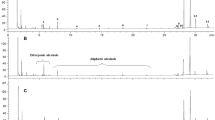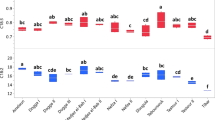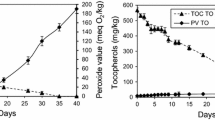Abstract
Reports on the methylsterol fractions of hazelnut oils are scarce. The objectives of this study were to characterize methylsterols in hazelnut and virgin olive oils and to study the possibility of detection of adulteration of virgin olive oils. In hazelnut oils, 4-desmethylsterols were present in higher proportions (86 to 91%) than in virgin olive oils where this fraction was ca. 50% of the total sterol. In the 4-monomethylsterol fraction, citrostadienol was the major component in both kinds of oils followed by cycloeucalenol and obtusifoliol in virgin olive oils, and obtusifoliol in hazelnut oils. 24-Methylenecycloartanol was predominant in both kinds of oils in the 4,4′-dimethylsterols. For the first time, δ-amyrin was tentatively identified by comparing published mass spectral data in the analyzed samples of both kinds of oils. An unknown compound X (containing a lupane skeleton) and lupeol were detected only in the 4,4′-dimethylsterols fraction of hazelnut oils at a level of 2–8 and 6–10%, respectively. GC-MS analysis showed that adulteration of virgin olive oil by hazelnut oil could be detected at a level less than 4% by using these two compounds as possible potential markers.
Similar content being viewed by others
References
Boskou, D., Olive Oil Composition, in Olive Oil: Chemistry and Technology, AOCS Press, Champaign, 1996, pp. 52–83.
Harwood, J.L., and P. Yaqoob, Nutritional and Health Aspects of Olive Oil, Eur. J. Lipid Sci. Technol. 104:685–697 (2002).
Aparicio, R., Authentication, in Handbook of Olive Oil: Analysis and Properties, edited by J. Harwood and R. Aparicio, Aspen, Gaithersburg, MD, 2000, pp. 491–520.
European Union Research Committee, Development and Assessment of Methods for the Detection of Adulteration of Olive Oil with Hazelnut Oil, Brussels (2001). http://europa.eu.int/ comm/research/press/2001/pr1110-oliveoil-en.html (accessed September 2005).
Cercaci, L., M.T. Rodriguez-Estrada, and G. Lercker, Solid-Phase Extraction-Thin Layer Chromatography—Gas Chromatography Method for the Detection of Hazelnut Oil in Olive Oils by Determination of Esterified Sterols, J. Chromatogr. A 985:211–220 (2003).
Christopoulou, E., M. Lazaraki, M. Komaitis, and K. Kaselimis, Effectiveness of Determinations of Fatty Acids and Triglycerides for the Detection of Adulteration of Olive Oils with Vegetable Oils, Food Chem. 84:463–474 (2004).
Vichi, S., L. Pizzale, E. Toffano, R. Bortolomeazzi, and L. Conte, Detection of Hazelnut Oil in Virgin Olive Oil by Assessment of Free Sterols and Triacylglycerols, Food Comp. Add. 84:1534–1541 (2001).
Zabaras, D., and M.H. Gordon, Detection of Pressed Hazelnut Oil in Virgin Olive Oil by Analysis of Polar Components: Improvement and Validation of the Method, Food Chem. 84:475–483 (2004).
Bøwadt, S., and R. Aparicio, The Detection of the Adulteration of Olive Oil with Hazelnut Oil: A Challenge for the Chemist, Inform 14:342–344 (2003).
Kochhar, S.P., Influence of Processing on Sterols of Edible Vegetable Oils, Prog. Lipid Res. 22:161–188 (1983).
Itoh, T., K. Yoshida, T. Yatsu, T. Tamura, and T. Matsumoto, Triterpene Alcohol and Sterols of Spanish Olive Oil, J. Am. Oil Chem. Soc. 58:545–550 (1981).
Kornfeldt, A., and L.B. Croon, 4-Demethyl-, 4-Monomethyl-and 4,4-Dimethylsterols in Some Vegetable Oils, Lipids 16:306–314 (1981).
Leon, A.M., V. Liuzzi, E. La Notte, and M. Santoro, Sterols, Methylsterols and Dimethylsterols of Some Vegetable Oils, with Particular Reference to the Olive Oils. Their Possible Function in the Characterization of Some Products. Their Variation in the Refining Process, Riv. Ital. Sostanze Grasse 61:69–89 (1984).
Carlos Bada, J., M. Leon-Camacho, M. Prieto, and L. Alonso, Characterization of Oils of Hazelnut Oils from Asturias. Spain, J. Lipid Sci. Technol. 106:294–300 (2004).
Parcerisa, L., I. Casals, J. Boatella, R. Codony, and M. Rafecas, Analysis of Olive and Hazelnut Oil Mixtures by High-Performance Liquid Chromatography-Atmospheric Pressure Chemical Ionization Mass Spectrometry of Triacylglycerols and Gas-Liquid Chromatography of Non-saponifiable Compounds (tocopherols and sterols), J. Chromatogr. A 881:149–158 (2000).
Parcerisa, J., D.G. Richardson, M. Rafecas, R. Codony, and J. Boatella, Fatty Acid, Tocopherol and Sterol Content of Some Hazelnut Varieties (Corylus avellana L.) Harvested in Oregon (USA), 805:259–268 (1998).
Savage, G.P., D.L. McNeil, and P.C. Dutta, Lipid Composition and Oxidative Stability of Oils in Hazelnuts (Corylus avellana L.) Grown in New Zealand, J. Am. Oil Chem. Soc. 74:755–759 (1997).
Dijk, M. Van, P. Daenes, and L. Larvelle, Study of the Unsaponifiable Fraction and Glyceride Composition of Corylus Oils, Rev. Fr. Corps Gras 22:619–622 (1975).
Sánchez, P.L.B., L.M. Camacho, and R. Aparicio, A Comprehensive Study of Hazelnut Oil Composition with Comparisons to Other Vegetable Oils, Particularly Olive Oil, Eur. Food Res. Technol. 218:13–19 (2003).
Ollivier, D., B. Bruckert, C. Noyer, M. Guérère, and A. Artaud, Multicriteria Analysis for the Research of Virgin Olive Oil by Hazelnut and Almond Oils, Ann. Falsif. Expert. Chim. 92:163–178 (1999).
Beveridge, T.H.J., T.S.C. Li, and J.C.G. Drover, Phytosterol Content in American Ginseng Seed Oil, J. Agric. Food Chem. 50:744–750 (2002).
Bauer, S., E. Schulte, and H.-P. Thier, Composition of the Surface Wax from Tomatoes. I: Identification of the Components by GC/MS, Eur. Food Res. Technol. 219:223–228 (2004).
Kamal-Eldin, A., L.A. Appelqvist, and G. Yousif, Seed Lipids of Sesamum indicum and Related Wild Species in Sudan. The Sterols, J. Sci. Food Agric. 59:327–334 (1992).
Mariani, C., G. Bellan, G. Morchio, and A. Pellegrino, Free and Esterified Minor Components of Olive and Hazelnut Oils: Their Potential Utilization in Checking Oil Blend. III, Riv. Ital. Sostanze Grasse 76:297–305 (1999).
Lercker, G., and M.T. Rodriguez-Estrada, Chromatographic Analysis of Unsaponifiable Compounds of Olive Oils and Fat-Containing Foods, J. Chromatogr. A 881:105–129 (2000).
Shiojima, S., Y. Arai, K. Masuda, Y. Takase, T. Ageta, and H. Ageta, Mass Spectra of Pentacyclic Tritepenoids, Chem. Pharm. Bull. 40:1683–1890 (1992).
Author information
Authors and Affiliations
Corresponding author
About this article
Cite this article
Damirchi, S.A., Savage, G.P. & Dutta, P.C. Sterol fractions in hazelnut and virgin olive oils and 4,4′-dimethylsterols as possible markers for detection of adulteration of virgin olive oil. J Amer Oil Chem Soc 82, 717–725 (2005). https://doi.org/10.1007/s11746-005-1133-y
Received:
Accepted:
Issue Date:
DOI: https://doi.org/10.1007/s11746-005-1133-y




